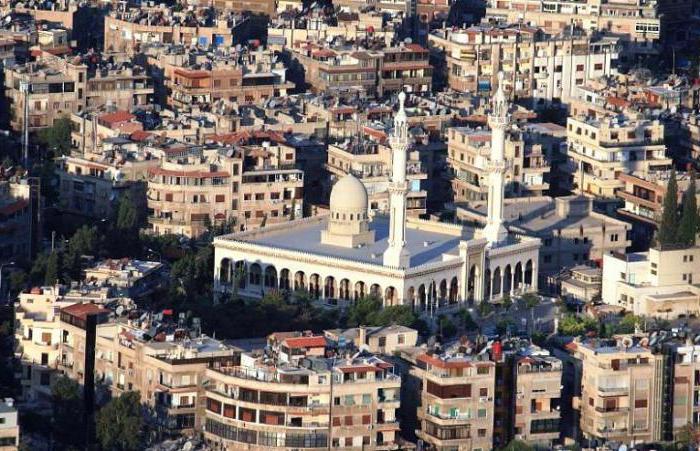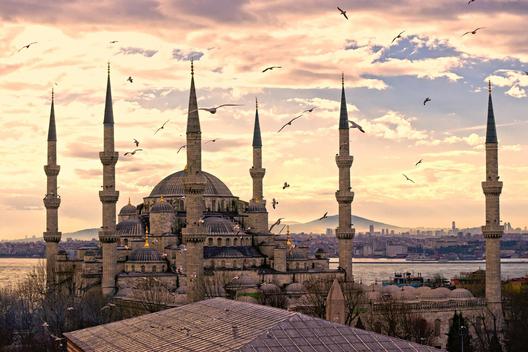Syria, attractions: palaces, castles and museums
Eastern state, which borders onTurkey, Jordan, Iraq, Israel and Lebanon, is the Syrian Arab Republic (Syria). The sights of this country have a thousand-year history. On this earth there are many historical, architectural monuments left from different civilizations. They have always attracted tourists from all over the world.
More recently, this country, which storesancient shrines, visited numerous pilgrims. But at the moment this land is embraced by the flame of a bloody war. Perhaps someone will say that now is not the time to talk about the sights of this region, when its long-suffering people die, or leave their homeland. But we decided to tell you about them in the hope that soon this madness will end and tourists from all over the world will come to see how beautiful Syria is. Its sights are unique, many are under the protection of UNESCO. We will introduce you to some of them.

Damascus
A city that is rightfully proud of Syria. We will begin to study the sights of the country from Damascus, the capital of the Syrian Republic. The city is on the banks of the river Barada. Historians believe that this is one of the oldest cities in the world. The first mention of it dates back to 2500 BC.
Its main attractions arecarry the city walls, which have seven gates leading to the Old Town, and several more gates beyond. In addition, it is, of course, the largest Umayyad Mosque in the country, numerous tombs and tombs, Salah-ad-Din (mausoleum), the ruins of the temple of Jupiter, the city cathedral, the chapel of St. Paul, the Azem palace, the oldest madrassas. Many churches store the relics and ashes of the saints, sacred relics, which are very dear to Syria. The sights of the city are also its parks. The largest in the capital - the park Tishrin, in addition, you can walk along the shady alleys of Al-Sibbka, Aljahiz and others. Local markets are always attracting visitors. The most famous of them are Bzuriya and Suq al-Hamidiyya.
Cracow-de-Chevaliers
Many historical buildings are famous forthe whole world is Syria. Its sights, for example, such as this fortress, are usually considered monuments of international importance. That is why the Krak-de-Chevalier is listed in the UNESCO list.
This is the former residence of the Hospitallers, which wasbuilt on a high hill. The thickness of its outer walls is five meters. For protection, thirteen towers were built and additionally an internal wall separated by a moat. There could be up to five thousand people at the same time.

In ancient times it was a formidable and reliable fortress,and today it is considered to be one of the most romantic castles. From the height of its walls you can admire the picturesque views. There is a cafe in one of the towers.
Qasr-ibn Vardan
Many historians and researchers are attracted toSyria. Sights, the description of which is found even in ancient documents, allow to judge how luxurious were many of them. Among them, this palace complex.
He is in the desert, near the city of Hama. Today it's ruins. Partially preserved only the central courtyard, part of the stables, the facade of the palace and its small part, public baths, as well as the church with the nave. The complex was built in the VI century as a protective structure. For its construction, marble and basalt were used. Understand the purpose of each structure can be from the images that are carved on the stones.

The Umayyad Mosque
Many temples, cathedrals, churches and mosqueshas on its territory Syria. The sights, the photos of which we have placed below, are the shrines of the Syrian people. The Umayyad Mosque is the largest and oldest in the world. On its territory is the grave of Salah-ad-Din (he was the ruler of the country in the 12th century), and also the relics of John the Baptist are kept. Here is also a chapel in which the relics of the Prophet Muhammad Hussein are buried.

The place where the mosque is located, since ancient timeswas allocated for the construction of religious buildings. At first, the temple of Hadad was built here, then the temple of Jupiter, and even later - the temple of John the Baptist. The mosque is richly and beautifully trimmed with onyx, marble, a colored glass. Doors are open to believers of all denominations. The only requirement for visitors - at the entrance to take off their shoes.
Damascus: National Museum
Not only specialists are attracted to Syria(Attraction). The National Museum of Damascus is located in the heart of the Syrian capital. Here are collected unique exhibits, which belong to a variety of epochs. For example, in the exposition you can see the first alphabet in the world, stone and marble sarcophagi, skeletons related to the Stone Age, very rare statues, letters and coins, jewelry and other antiques and artifacts. In one of the halls the situation of the Syrian house is reproduced. But tourists especially like to visit the reconstructed ancient Dura-Europos Synagogue.

Syria, attractions: Railway Museum
He is one of the oldest in Damascus. In a small open area, a collection of "prototypes" of modern railway transport is collected. Among them there are even exhibits made of wood. The models of steam locomotives that remained in Syria from the British were also preserved.

The exposition, numbering more than ten exhibits, needs restoration, which costs a lot of money. But the museum's management still does not charge visitors for entrance fees.
Sights of Syria. What to see in Syria?
In addition to Damascus, there are many interesting andmemorable places. For example, Palmira ("city of palm trees"). Once it was an influential ancient city, which was an important point on the Great Silk Road. Today it is a dead city, which is in the Syrian desert.

In honor of him, several cities are named in the USA, andsometimes our St. Petersburg is also called the North Palmira. The ruins of ancient buildings include the ruins of ancient buildings: the Bela temple complex, which is surrounded by a high wall, a shopping area, a colonnade, a theater, thermal baths, apartment buildings, a triumphal arch, Palmyra fare (stela) and much more.
On the territory of Palmyra were launchedarchaeological excavations only in the XIX century and they continue to this day. In addition to the picturesque ruins, in the border of the city there is a small residential settlement and a museum. All the structures of Palmira are protected by UNESCO.
Azem Palace
If you are interested in Syria(sights), the palace of Azema you should see by all means. This is one of the impressive secular buildings, dating back to the period of Turkish rule. The complex harmoniously combines Arab and Turkish architectural elements.
This palace allows you to look into the past. As required by Islamic customs, the outside of the building seems modest and fairly simple. A high, gray, completely unadorned clay wall surrounds a huge (5,500 sq. M.) Square in the central part of the Old Town, near the Umayyad Mosque. But it is worth the visitor to go through the gate, as before it opens a completely different world, full of abundance, beauty, luxury.

In the courtyard lined with marbleslabs, large flower beds are broken, regularly taken care of, and citrus trees are also planted here. They give a shadow, and fountains give the summer such a desired coolness. On three sides the courtyard is surrounded by a covered colonnade, from which you can go to the numerous rooms of a luxurious palace.
History of the palace
This grandiose construction was erectedgovernor of the Turkish sultan in the XVIII century. For its construction were bought, and sometimes simply confiscated jewelry from the houses of local nobility. Those who are fortunate enough to see this palace will understand that the post of viceroy in the old days was very profitable. That's probably why 130 governors in 180 years have been replaced in Damascus.
Excursions
The museum is interesting and instructiveexcursions. In one of the rooms this scene is reproduced. On the soft low sofa, inaccessible and proud, sits the pasha. His head is decorated with a red fez. At a respectful distance from him, the clerks and the Viziers settled down waiting for orders. And all this is complemented by a magnificent design - the walls are lined with marble, the ceilings are two stories high ... Even in the summer heat in the room is cool. In numerous niches and on consoles there is an expensive earthenware, fine products from porcelain and glass.
In the next room you can see the scenepreparing the bride for the wedding. This room is also luxurious: inlaid furniture made by famous Syrian carpenters, lots of beautiful dishes, carpets, expensive lamps ...
Hamam Nureddin Shahir
A great interest for many tourists of their differentcountries represented by Syria. Attractions (the hamam Nureddin al Shahir - the most famous in Damascus) it is represented not only by museums, temples and palaces, but also by baths. We will describe one of them further.
There is an object in the old town, not far frommarket of Al-Hamidiyah. This hamam, who turned almost a thousand years old, is very popular today. Here there are more than ten banschikov. The name "Hamam" comes from the Arabic word "boor" - "heat". The idea of a hamam was borrowed from the Romans by the Romans, and much later was handed over to the Turks.
Hamam Nureddin Shahir works until 24:00. But the best time for his visit is the morning. According to experts, the steam at this time of day is fresh, there is enough space, and the bathhouse attendants are vigorous and work with full dedication. Women can visit the hamam only on Friday - Muslim holiday.

Zaharia Madrasah
A huge and vivid impression is produced ontourists from Syria (sights). Madrasah Zacharias is a mausoleum located in the capital of the country. Here rests one of the most famous sultans, who bravely fought in Palestine. His name is Baybars. Many are sure that he is buried in Cairo, but this is an erroneous statement. On the territory of the mausoleum there is also an archive and a school. Recently the building was restored. The walls were restored mosaic and drawings. The archive of the mausoleum contains a huge collection of rare books (more than 200 thousand). The building was erected in 1266.
</ p>




